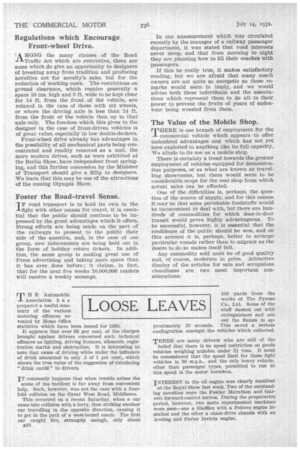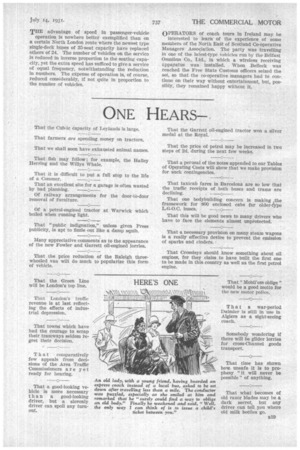Regulations which Encourage Front-wheel Drive.
Page 36

Page 37

If you've noticed an error in this article please click here to report it so we can fix it.
AMONG the many clauses of the Road Traffic Act which are restrictive, there are some which do give an opportunity to designers of breaking away from tradition and producing novelties not for novelty's sake, but for the reduction of working costs. The restrictions on ground clearance, which require generally a space 10 ins, high and 5 ft. wide to be kept clear for 14 ft. from the front. of the vehicle, are relaxed in the case of those with six wheels, or where the driving axle is less than 14 ft. from the front of the vehicle then up to that axle only. The freedom which this gives to the designer in the case of front-driven vehicles is of great value, especially in low double-deckers.
Front-wheel drive already has advantages in the possibility of all mechanical parts being concentrated and readily removed as a unit, the more modern drives, such as were exhibited at the Berlin Show, have independent front springing, and this further concession by the Minister of Transport should give a fillip to designers. We learn that this may be one of the attractions of the coming Olympia Shaw.
Foster the Road-travel Sense.
JF road transport is to hold its own in the fight with other means for trayel, it is essential that the public should continue to be impressed by the great advantages which it offers. Strong efforts are being made on the part of the railways to present to the public their side of the question, and, in the case of one group, new inducements are being held out in the form of holiday return tickets. In addition, the same group is making great use of Press advertising and taking more space than it has ever done before ; it claims, in fact, that for the next five weeks 10,000,000 readers will receive a weekly message. In one announcement which was circulated recently by the manager of a railway passenger department, it was stated that road interests never sleep, and that from morning to night they are planning how to fill their coaches with passengers.
If this be really true, it makes satisfactory reading, but we are afraid that many coach owners are not quite so energetic as these remarks would seem to imply, and we would advise both these individuals and the associations which represent them to do all in their power to prevent the fruits of years of endeavour being wrested from them.
The Value of the Mobile Shop.
THERE is one branch of employment for the commercial vehicle which appears to offer undoubted advantages and which has not yet been exploited to anything like its full capacity. We allude to its use as a mobile shop.
There is certainly a trend towards the greater employment of vehicles equipped for demonstration purposes, or as what are known as travelling showrooms, but there would seem to be considerable scope for the real shop from which actual sales can be effected.
One of the difficulties is, perhaps, the question of the source of supply, and for this reason It may be that some perishable foodstuffs would be inconvenient to deal with, but there are hundreds of commodities for which door-to-door transit would prove highly advantageous. To be successful, however, it is essential that the confidence of the public should be won, and on this account it is, perhaps, better to arrange particular rounds rather than. to migrate as the desire to do so makes itself felt.
Any commodity sold muk be of good quality and, of course, moderate in price. Attractive display of the articles for sale and scrupulous cleanliness are two most important considerations.' THE advantage of speed in passenger-vehicle
operation is nowhere better exemplified than on a certain North London route where the newest type single-deck buses of 35-seat capacity have replaced others of 24. The number of vehicles on the service is reduced in inverse proportion to the seating capacity, yet the extra speed has sufficed to give a service of equal frequency, notwithstanding the reduction in numbers. The expense of operation is, of course, reduced considerably, if not quite in proportion to the number of vehicles. OPERATORS of coach tours in Ireland may be
interested to learn of the experience of some members of the North East of Scotland Co-operative Managers Association. The party was travelling in one of the latest-type vehicles run by the Belfast Omnibus Co., Ltd., in which a wireless receiving apparatus was installed. When Belleek was reached the Free State Customs officers seized the set, so that the co-operative managers had to continue on their way without entertainment, but, possibly, they remained happy without it.




































































































